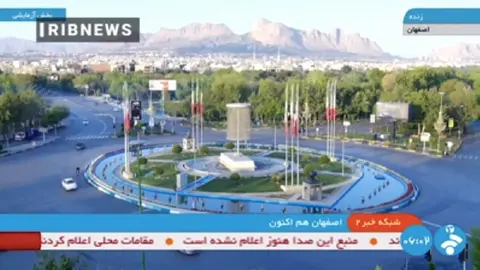Iranian threats that fizzled

The only certainty is that Iran controls the region with the weapons of its proxy militias, its sectarian propaganda and proselytising tools, but not through its ballistic missiles, cruise missiles or its “kamikaze” drones.
One of the best diplomatic terms which countries use to acknowledge their inability to fully or partially face up to an enemy with greater capabilities is to say that they “reserve the right to respond” and then move on.
For years, the Syrians have been “reserving” this right after each Israeli raid on their territory. The Israelis have targeted, among others, Iranian military equipment intended for use by the Revolutionary Guards in Syria or due to be sent to Hezbollah in Lebanon. Iran itself benefited from “reserving the right of response,” given that the Israelis often attacked Syrian military targets where Iranian advisors “happened” to be present.
Amid regional tensions fuelled by the war in Gaza, Israel decided to take out General Mohammad Reza Zahedi, a senior commander entrusted with coordinating Iranian operations targeting Israel from Syria and Lebanon. Zahedi, used to be Qassem Soleimani’s comrade-in-arms. The latter was Iran’s lead man in Iraq and the north of Syria while Zahedi oversaw Iranian activities on the Syrian coast and the Golan and was also in charge of directing and arming Lebanon’s Hezbollah.
When the US killed Iran’s Qods Force chief Qassem Soleimani, Iran responded with a feeble show of force consisting of limited Scud missile strikes at two US airbases in Iraq. The strikes had very little impact as they caused only concussions to a few American soldiers on the bases. Tehran did not seem to learn from its mistake of demonstrating its limitations through the attack. At the end of last week, it assembled hundreds of drones, ballistic missiles and cruise missiles in a operation prepared over a period of two weeks with the aim of retaliating for Zahedi’s killing. This Iranian response, despite all its dazzling optics, was even less effective than the Hamas and Hezbollah missile attacks on Israel.
Iran missed the opportunity to hold its cards close to its chest, like any poker player who deliberately bluffs while not revealing the deal he has in his hands. It chose to respond while it would have better served its interests to just diplomatically “reserve the right to respond”.
There are many military, organisational and geographical considerations that misled Iran into believing that it possessed the proper means to respond to Israel.
Some of the Iranian missiles and drones which Tehran supplied to the Houthis were able to penetrate southern Saudi Arabia’s defences. The Iranians and their proxies became even more emboldened when they succeeded in striking Aramco’s oil facilities in 2019. The Iranians believed the US did not respond to their attack for operational reasons, meaning that it was not militarily prepared to hit back. In reality, the administration of US President Donald Trump was playing political games with Saudi Arabia and other Gulf nations, even though it has been never made clear why Saudi ground defences were unable to intercept the attacking drones and cruise missiles or even to attempt to do so.
Iran’s understanding of Russia’s successes in Ukraine has been riddled with misinterpretations. Operated by Russians, Iranian drones where quite efficient in striking Ukrainian targets. During last Saturday’s attack, Iranian drones overflew Iraqi cities on their way to their Israeli targets with their trajectory caught on camera. The drones were of the same Shahed “kamikaze” drones used by Russia to attack Ukraine. The Iranian assumption therefore was that since these drones were effective in Europe, why would not they be so in the Middle East as well? The Iranians did not see the difference between the sprawling geography of Ukraine and Israel’s much smaller area. Ukraine’s vast territory complicated the task of the country’s air defences. In Israel’s case, the area is small and the country is more than a thousand kilometres away from Iran’s nearest border. Furthermore, drones and cruise missiles have to cross the airspace of at least two countries and perhaps three, namely Iraq, Jordan and Syria, before reaching Israeli airspace.
There are historical examples of how the types of weapons used by Iran were repelled. Late in World War II, the Germans produced two types of missiles. The first was the V-1 rocket, a cruise missile, which flew like an air plane and then pounced on its targets. The second was V-2 ballistic missile, which was launched to high altitudes before re-entering the atmosphere in a trajectory similar to that of vessels returning from outer space. The Germans used V-1 cruise missiles, but the British responded to them with air ambushes as fighter aircraft were able to shoot down many of them. It took decades for military technology to catch up with ballistic missiles like the V-2 as demonstrated in the war to liberate Kuwait in 1991, and for Patriot missiles to be able to shoot down Scud missiles (which constitute an advanced but similar version of the original German rockets).
What happened last Saturday night was a combination of both. American, British, Jordanian, and certainly Israeli fighters carried out aerial ambushes shooting down relatively slow-moving cruise missiles, while Israel’s “Iron Dome” and US Patriot missiles dealt with Iran’s ballistic missiles. The progress of the “Shahed” drones after their launch is slow. Their power resides in manoeuvring in swarm patterns making the task of intercepting them difficult by virtue of their sheer numbers. But even with this theoretical advantage, the drones were no match for the capabilities of two American aircraft carriers stationed in the region with dozens of advanced combat aircraft onboard, and an additional number of British warplanes taking off from Cyprus and Jordanian aircraft defending their country’s airspace. There were also the upgraded versions of the “Iron Dome” missiles at the disposal of Israel as it sought to intercept the smaller rockets launched by Hamas from Gaza and the projectiles and drones lobbed by Hezbollah from South Lebanon.
In any case, all Iranian weapons were exposed from the moment they were launched, providing the Israelis, the Americans and their allies with enough time to monitor their movement and adequately respond to their threat.
In the final analysis, Iranian weapons seem well suited to threaten the Gulf nations because of their proximity, but in their current form they are incapable of striking a blow at Israel. Had Iran been convinced that retaliation and its consequences were worth the trouble of involving a proxy of Hezbollah’s calibre, the Lebanese militant party, with its missile capabilities and geographical proximity, would have been the best tool for retaliation.
As I mentioned in my previous oped, Zahedi’s blood is not worth sacrificing Hezbollah and its hold on Lebanon. Because of its operational miscalculations, the shortcomings of its currently available military capabilities and its reluctance to drag Hezbollah into an open confrontation with Israel, if not also the United States and the West, Tehran put on a meagre military and political display. The Iranians would have been better served to continue threatening to retaliate while “reserving the right to respond”.
This does not mean that the Iranian threat should be underestimated. Iran realises, more than ever, that its proxies and loyal militias across the Middle East are its best means of imposing its clout through intimidation, as well by creating the psychological and media illusions to the peoples of the region that Iran and its allies are the only ones capable of standing up to Israel and avenging the Palestinians in Gaza.
Today, there will be a lot of confusion in the region created by the belief of some that we have been witnesses to a “show” put on by Iranians, Americans and Israelis, and also by the perception this was an “heroic” response on the part of Iran to Israel, or maybe a first round in the first direct military confrontation between Iran and Israel, after more than 40 years of sermons from the pulpits of Shia Husseiniyat and mosques of Tehran with talk about “the road to Jerusalem passing through Karbala.” The only certainty is that Iran controls the region with the weapons of its proxy militias, its sectarian propaganda and proselytising tools, and not through its ballistic missiles, cruise missiles or its “kamikaze” drones.
What has been made clear by Iran’s supposed retaliation is that the impact of its drones and missiles on Israel is no different from that of its decades-long rhetorical threats.



